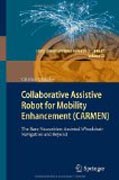
Collaborative assistive robot for mobility enhancement (CARMEN): the bare necessities : assisted wheelchair navigation and beyond
Urdiales, Cristina
In nowadays aging society, many people require mobility assistance. Sometimes, assistive devices need a certain degree of autonomy when users' disabilitiesdifficult manual control. However, clinicians report that excessive assistance may lead to loss of residual skills and frustration. Shared control focuses on deciding when users need help and providing it. Collaborative control aims at giving just the right amount of help in a transparent, seamless way. This book presents the collaborative control paradigm. User performance may be indicative of physical/cognitive condition, so it is used to decide how much help is needed. Besides, collaborative control integrates machine and user commands so that people contribute to self-motion at all times. Collaborative control was extensively tested for 3 years using a robotized wheelchair at a rehabilitation hospital in Rome with volunteer inpatients presenting different disabilities, ranging from mild to severe. We also present a taxonomy of common metricsfor wheelchair navigation and tests are evaluated accordingly. Obtained results are coherent both from a quantitative and qualitative point of view. Casual and desriptive handbook to robotic wheelchair construction, plus a new method to support wheelchair based person-mobility through collaborative control. The specifics of experiments at hospitals are described in the book aswell and has been tested in a real hospital. Written by a leading expert in the field. INDICE: From the content: On the why of robotic assistive devices. A Dummy’s Guide to Assistive Navigation Devices. From shared control to collaborativenavigation. Bigger, faster, better, more!. If I only had a brain. Once more, with feeling.
- ISBN: 978-3-642-24901-3
- Editorial: Springer Berlin Heidelberg
- Encuadernacion: Cartoné
- Páginas: 260
- Fecha Publicación: 14/11/2011
- Nº Volúmenes: 1
- Idioma: Inglés
